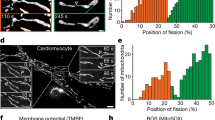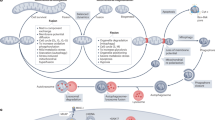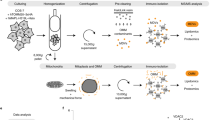Abstract
Plasma membrane lipid microdomains have been considered as a sort of ‘closed chamber’, where several subcellular activities, including CD95/Fas-mediated proapoptotic signaling, take place. In this work we detected GD3 and GM3 gangliosides in isolated mitochondria from lymphoblastoid CEM cells. Moreover, we demonstrated the presence of microdomains in mitochondria by immunogold transmission electron microscopy. We also showed that GD3, the voltage-dependent anion channel-1 (VDAC-1) and the fission protein hFis1 are structural components of a multimolecular signaling complex, in which Bcl-2 family proteins (t-Bid and Bax) are recruited. The disruption of lipid microdomains in isolated mitochondria by methyl-β-cyclodextrin prevented mitochondria depolarization induced by GD3 or t-Bid. Thus, mitochondrion appears as a subcompartmentalized organelle, in which microdomains may act as controllers of their apoptogenic programs, including fission-associated morphogenetic changes, megapore formation and function. These results disclose a new scenario in which mitochondria-associated lipid microdomains can act as regulators and catalysts of cell fate.
Similar content being viewed by others
Log in or create a free account to read this content
Gain free access to this article, as well as selected content from this journal and more on nature.com
or
Abbreviations
- BSA:
-
bovine serum albumin
- COX-4:
-
cytochrome c oxidase
- Cyt c:
-
cytochrome c
- ΔΨ:
-
mitochondrial membrane potential
- DISC:
-
death-inducing signaling complex
- EGTA:
-
ethylene glycol-bis(-aminoethyl ether) N,N′,N″-tetraacetic acid
- ER:
-
endoplasmic reticulum
- FCS:
-
fetal calf serum
- FITC:
-
fluorescein isothiocyanate
- GEM:
-
glycosphingolipid enriched microdomains
- GM-130:
-
Golgi marker 130
- HPTLC:
-
high-performance thin layer chromatography
- HRP:
-
horseradish peroxidase
- LAMP-1:
-
lysosome-associated membrane glycoprotein
- MβCD:
-
methyl-β-cyclodextrin
- MoAb:
-
monoclonal antibody
- MOPS:
-
3[N-Morpholino] butane-sulfonic acid
- PBS:
-
phosphate-buffered saline
- PKC:
-
protein kinase C
- PMSF:
-
phenylmethylsulfonyl fluoride
- PVDF:
-
polyvinilidene difluoride
- SB:
-
swelling buffer
- SDS-PAGE:
-
sodium-dodecyl sulphate polyacrilamide gel electrophoresis
- TEM:
-
transmission electron microscopy
- TMRM:
-
tetramethylrhodamine-methyl-ester-perchlorate
- VDAC-1:
-
voltage-dependent anion channel-1
References
Ardail D, Popa I, Bodennee J, Louisot P, Schmitt D and Portoukalian J (2003) The mitochondria-associated endoplasmic-reticulum subcompartment (MAM fraction) of rat liver contains highly active sphingolipid-specific glycosyltransferases. Biochem. J. 371: 1013–1019
Birbes H, El Bawab S, Hannun YA and Obeid LM (2001) A mitochondrial pool of sphingomyelin is involved in TNFalpha-induced Bax translocation to mitochondria. FASEB J. 14: 2669–2679
Kiguchi K, Henning-Chubb BC and Huberman E (1990) Glycosphingolipid patterns of peripheral blood lymphocytes, monocytes, and granulocytes are cell specific. J. Biochem. (Tokyo) 107: 8–14
Pizzo P and Viola A (2003) Lymphocyte lipid rafts: structure and function. Curr. Opin. Immunol. 15: 255–260
Garofalo T, Lenti L, Longo A, Misasi R, Mattei V, Pontieri GM, Pavan A and Sorice M (2002) Association of GM3 with Zap-70 induced by T cell activation in plasma membrane microdomains: GM3 as a marker of microdomains in human lymphocytes. J. Biol. Chem. 277: 11233–11238
Garofalo T, Misasi R, Mattei V, Giammarioli AM, Malorni W, Pontieri GM, Pavan A and Sorice M (2003) Association of the death-inducing signaling complex with microdomains after triggering through CD95/Fas. Evidence for caspase-8-ganglioside interaction in T cells. J. Biol. Chem. 278: 8309–8315
Muppidi JR and Siegel RM (2004) Ligand-independent redistribution of Fas (CD95) into lipid rafts mediates clonotypic T cell death. Nat. Immunol. 5: 182–189
Algeciras-Schimnich A, Shen L, Barnhart BC, Murmann AE, Burkhardt JK and Peter ME (2002) Molecular ordering of the initial signaling events of CD95. Mol. Cell. Biol. 22: 207–220
Hueber AO, Bernard AM, Herincs Z, Couzinet A and He HT (2002) An essential role for membrane rafts in the initiation of Fas/CD95-triggered cell death in mouse thymocytes. EMBO Rep. 3: 190–196
De Maria R, Lenti L, Malisan F, d'Agostino F, Tomassini B, Zeuner A, Rippo MR and Testi R (1997) Requirement for GD3 ganglioside in CD95- and ceramide-induced apoptosis. Science 277: 1652–1655
Giammarioli AM, Garofalo T, Sorice M, Misasi R, Gambardella L, Gradini R, Fais S, Pavan A and Malorni W (2001) GD3 glycosphingolipid contributes to Fas-mediated apoptosis via association with ezrin cytoskeletal protein. FEBS Lett. 506: 45–50
Ikonen E (2001) Roles of lipid rafts in membrane transport. Curr. Opin. Cell Biol. 13: 470–477
Garcia-Ruiz C, Colell A, Morales A, Calva M, Enrich C and Fernandez-Checa JC (2002) Trafficking of ganglioside GD3 to mitochondria by tumor necrosis factor-alpha. J. Biol. Chem. 277: 36443–36448
De Maria R, Rippo MR, Schuchman HE and Testi R (1998) Acidic sphingomyelinase (ASM) is necessary for fas-induced GD3 ganglioside accumulation and efficient apoptosis of lymphoid cells. J. Exp. Med. 187: 897–902
Rippo MR, Malisan F, Ravagnan L, Tomassini B, Condo I, Costantini P, Susin SA, Rufini A, Todaro M, Kroemer G and Testi R (2000) GD3 ganglioside directly targets mitochondria in a bcl-2-controlled fashion. FASEB J. 14: 2047–2054
Garcia-Ruiz C, Colell A, Paris R and Fernandez-Checa JC (2000) Direct interaction of GD3 ganglioside with mitochondria generates reactive oxygen species followed by mitochondrial permeability transition, cytochrome c release, and caspase activation. FASEB J. 14: 847–858
Karbowski M and Youle RJ (2003) Caspase inhibition prevents the mitochondrial release of apoptosis-inducing factor. Cell Death Differ. 10: 870–880
Matarrese P, Tinari A, Mormone E, Bianco GA, Toscano MA, Ascione B, Rabinovich GA and Malorni W (2005) Galectin-1 sensitizes resting human T lymphocytes to Fas (CD95)-mediated cell death via mitochondrial hyperpolarization, budding, and fission. J. Biol. Chem. 280: 6969–6985
van Blitterswijk WJ, van der Luit AH, Veldman RJ, Verheij M and Borst J (2003) Ceramide: second messenger or modulator of membrane structure and dynamics? Biochem. J. 369: 199–211
Misasi R, Sorice M, Garofalo T, Griggi T, Giammarioli AM, d'Ettorre G, Vullo V, Pontieri GM, Malorni W and Pavan A (2000) Overexpression of lymphocytic GD3 ganglioside and presence of anti-GD3 antibodies in patients with HIV infection. AIDS Res. Hum. Retroviruses 16: 1539–1549
Scorrano L, Petronilli V, Di Lisa F and Bernardi P (1999) Commitment to apoptosis by GD3 ganglioside depends on opening of the mitochondrial permeability transition pore. J. Biol. Chem. 274: 22581–22585
Cheng EHY, Sheiko TV, Fisher JK, Craigen WJ and Korsmeyer SJ (2003) VDAC2 inhibits BAK activation and mitochondrial apoptosis. Science 301: 513–517
Sorice M, Circella A, Cristea IM, Garofalo T, Di Renzo L, Alessandri C, Valesini G and Degli Esposti MD (2004) Cardiolipin and its metabolites move from mitochondria to other cellular membranes during death receptor-mediated apoptosis. Cell Death Differ. 11: 1133–1145
Wei MC, Zong WX, Cheng EH, Lindsten T, Panoutsakopoulou V, Ross AJ, Roth KA, MacGregor GR, Thompson CB and Korsmeyer SJ (2001) Proapoptotic BAX and BAK: a requisite gateway to mitochondrial dysfunction and death. Science 292: 727–730
Shimizu S, Narita M and Tsujimoto Y (1999) Bcl-2 family proteins regulate the release of apoptogenic cytochrome c by the mitochondrial channel VDAC. Nature 399: 483–487
Shimizu S, Ide T, Yanagida T and Tsujimoto Y (2000) Electrophysiological study of a novel large pore formed by Bax and the voltage-dependent anion channel that is permeable to cytochrome c. J. Biol. Chem. 275: 12321–12325
Kim TH, Zhao Y, Ding WX, Shin JN, He X, Seo YW, Chen J, Rabinowich H, Amoscato AA and Yin XM (2004) Bid-cardiolipin interaction at mitochondrial contact site contributes to mitochondrial cristae reorganization and cytochrome C release. Mol. Biol. Cell 15: 3061–3072
Lange Y (1991) Disposition of intracellular cholesterol in human fibroblasts. J. Lipid Res. 32: 329–339
Van Meer G (1989) Lipid traffic in animal cells. Annu. Rev. Cell Biol. 5: 247–275
Simons K and Ikonen E (1997) Functional rafts in cell membranes. Nature 387: 569–572
Ayllon V, Fleischer A, Cayla X, Garcia A and Rebollo A (2002) Segregation of Bad from lipid rafts is implicated in the induction of apoptosis. J. Immunol. 168: 3387–3393
Fleischer A, Ghadiri A, Dessauge F, Duhamel M, Cayla X, Garcia A and Rebollo A (2004) Bad-dependent rafts alteration is a consequence of an early intracellular signal triggered by interleukin-4 deprivation. Mol. Cancer Res. 2: 674–684
Gajate C, Del Canto-Janez E and Acuna AU (2004) Intracellular triggering of Fas aggregation and recruitment of apoptotic molecules into Fas-enriched rafts in selective tumor apoptosis. J. Exp. Med. 200: 356–365
Nicholson DW and McMurray WC (1986) Triton solubilization of proteins from pig liver mitochondrial membranes. Biochim. Biophys. Acta 856: 515–525
Scorrano L, Ashiya M, Buttle K, Weiler S, Oakes SA, Mannella CA and Korsmeyer SJ (2002) A distinct pathway remodels mitochondrial cristae and mobilizes cytochrome c during apoptosis. Dev. Cell 2: 55–67
Epand RF, Martinou JC, Fornallaz-Mulhauser M, Hughes DW and Epand RM (2002) The apoptotic protein tBid promotes leakage by altering membrane curvature. J. Biol. Chem. 277: 32632–32639
Bossy-Wetzel E, Barsoum MJ, Godzik A, Schwarzenbacher R and Lipton SA (2003) Mitochondrial fission in apoptosis, neurodegeneration and aging. Curr. Opin. Cell Biol. 15: 706–716
James DI, Parone PA, Mattenberger Y and Martinou JC (2003) hFis1, a novel component of the mammalian mitochondrial fission machinery. J. Biol. Chem. 278: 36373–36379
Karbowski M, Lee YJ, Gaune B, Jeong SY, Frank S, Nechushtan A, Santel A, Fuller M, Smith CL and Youle RJ (2002) Spatial and temporal association of Bax with mitochondrial fission sites, Drp1, and Mfn2 during apoptosis. J. Cell Biol. 159: 931–938
Godlewski MM, Gajkovska B, Lamparska-Przybysz M and Motyl T (2002) Colocalization of BAX with BID and VDAC-1 in nimesulide-induced apoptosis of human colon adenocarcinoma COLO 205 cells. Anti-Cancer Drugs 13: 1017–1029
Foley GE, Lazarus H, Farber S, Uzman BG, Boone BA and McCarthy RE (1965) Continuous culture of human lymphoblasts from peripheral blood of a child with acute leukemia. Cancer 18: 522–529
Zamzami N, Maisse C, Metivier D and Kroemer G (2001) Measurement of membrane permeability and permeability transition of mitochondria. Methods Cell Biol. 65: 147–158
Kotani M, Kawashima I, Ozawa H, Ogura K, Ishizuka I, Terashima T and Tai T (1994) Immunohistochemical localization of minor gangliosides in the rat central nervous system. Glycobiology 4: 855–865
Svennerholm L and Fredman PA (1980) A procedure for the quantitative isolation of brain gangliosides. Biochim. Biophys. Acta 617: 97–109
Williams MA and McCluer RH (1980) The use of Sep-Pak C18 cartridges during the isolation of gangliosides. J. Neurochem. 35: 266–269
Svennerholm L (1957) Quantitative estimation of sialic acids. II. A colorimetric resorcinol–hydrochloric acid method. Biochim. Biophys. Acta 24: 604–611
Hancock K and Tsang VC (1983) India ink staining of proteins on nitrocellulose paper. Anal. Biochem. 133: 157–162
Rodgers W and Rose JK (1996) Exclusion of CD45 inhibits activity of p56lck associated with glycolipid-enriched membrane domains. J. Cell Biol. 135: 1515–1523
Skibbens JE, Roth MG and Matlin KS (1989) Differential extractability of influenza virus hemagglutinin during intracellular transport in polarized epithelial cells and nonpolar fibroblasts. J. Cell Biol. 108: 821–832
Degli Esposti M, Ferry G, Masdehors P, Boutin JA, Hickman JA and Dive C (2003) Post-translational modification of Bid has differential effects on its susceptibility to cleavage by caspase 8 or caspase 3. J. Biol. Chem. 278: 15749–15757
Huber LA, Xu Q, Jurgens G, Bock G, Buhler E, Gey KF, Schonitzer D, Trall KN and Wick G (1991) Correlation of lymphocyte lipid composition membrane microviscosity and mitogen response in the aged. Eur. J. Immunol. 21: 2761–2765
Acknowledgements
We thank Dr. Mauro Degli Esposti, University of Manchester, UK; Dr. Stefano Rufini, University of Rome ‘Tor Vergata’, Italy; and Dr. Paola Matarrese, Istituto Superiore di Sanità, Rome, Italy, for helpful suggestions and criticisms. This work was supported by grants from Ministero della Salute, Italy to MS AP and WM.
Author information
Authors and Affiliations
Corresponding author
Additional information
Edited by JP Medema
Rights and permissions
About this article
Cite this article
Garofalo, T., Giammarioli, A., Misasi, R. et al. Lipid microdomains contribute to apoptosis-associated modifications of mitochondria in T cells. Cell Death Differ 12, 1378–1389 (2005). https://doi.org/10.1038/sj.cdd.4401672
Received:
Revised:
Accepted:
Published:
Issue date:
DOI: https://doi.org/10.1038/sj.cdd.4401672
Keywords
This article is cited by
-
The effect of folate-appended methyl-β-cyclodextrin increases on survival rates in a peritoneal dissemination mouse models of human ovarian cancer
Journal of Inclusion Phenomena and Macrocyclic Chemistry (2022)
-
LRP6 mediated signal transduction pathway triggered by tissue plasminogen activator acts through lipid rafts in neuroblastoma cells
Journal of Cell Communication and Signaling (2020)
-
Association of fission proteins with mitochondrial raft-like domains
Cell Death & Differentiation (2010)
-
Mitochondria, cholesterol and amyloid β peptide: a dangerous trio in Alzheimer disease
Journal of Bioenergetics and Biomembranes (2009)
-
Bax activation and stress-induced apoptosis delayed by the accumulation of cholesterol in mitochondrial membranes
Cell Death & Differentiation (2008)



